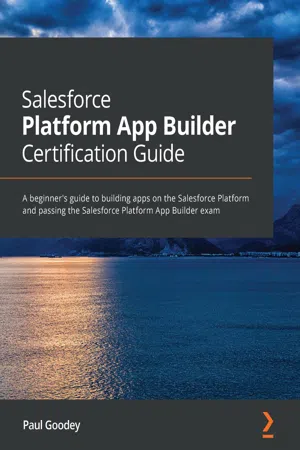
Salesforce Platform App Builder Certification Guide
A beginner's guide to building apps on the Salesforce Platform and passing the Salesforce Platform App Builder exam
- 412 pages
- English
- ePUB (mobile friendly)
- Available on iOS & Android
Salesforce Platform App Builder Certification Guide
A beginner's guide to building apps on the Salesforce Platform and passing the Salesforce Platform App Builder exam
About This Book
Get up to speed with the essential concepts and techniques necessary to prepare for the Salesforce Platform App Builder certification exam
Key Features
- Prepare for the Salesforce Platform App Builder certification exam by exploring important concepts and expert tips and techniques
- Design the data model, user interface, business logic, and security for custom apps
- Understand the key milestones and considerations when managing an application lifecycle
Book Description
Do you want to be able to confidently design and build apps that support business processes within the Lightning Platform? Salesforce Platform App Builder Certification Guide not only helps you to do this, but also prepares you for the certification exam.
The book starts by describing the core capabilities of the Lightning Platform. You'll learn techniques for data modeling to design, build, and deploy apps without writing code and achieve rapid results with the declarative capabilities that the Lightning Platform provides. Next, you'll explore utilities for importing and exporting data and the features available in the Lightning Platform to restrict and extend access to objects, fields, and records. You'll also be able to customize the Salesforce Lightning Experience user interface (UI) and build functionality for custom buttons, links, and actions. Later, this certification study guide will take you through reporting and the social and mobile features of the Lightning Platform. Finally, you'll get to grips with Salesforce build environments and deployment options.
By the end of this Salesforce book, you'll not only have learned how to build data models, enforce data security, and implement business logic and process automation, but also have gained the confidence to pass the Platform App Builder exam and achieve Salesforce certification.
What you will learn
- Explore the core features of the Lightning Platform
- Design and build an appropriate data model for a given scenario
- Identify the Lightning Platform's features and capabilities
- Customize the Salesforce Lightning Experience UI
- Implement business logic and process automation
- Identify the capabilities of declarative customization
Who this book is for
This book is for beginners and aspiring developers who want to learn how to build apps on the Salesforce Platform or pass the Salesforce Platform App Builder certification exam. Salesforce administrators and existing Salesforce Lightning Platform developers looking to learn more about the declarative, non-programmatic app building capabilities of the Salesforce Lightning Platform will also find this book useful.
Frequently asked questions
Information
Section 1: Introduction to the Lightning Platform Core
- Chapter 1, Core Capabilities of the Lightning Platform
- Chapter 2, Designing and Building a Data Model
- Chapter 3, Importing and Exporting Data
Chapter 1: Core Capabilities of the Lightning Platform
- Exam objectives: Salesforce Fundamentals
- What is the Salesforce Lightning Platform?
- Standard Salesforce CRM objects
- Customization options within the Lightning Platform
- Salesforce AppExchange
- Questions to test your knowledge
Exam objectives – Salesforce Fundamentals
- Describe the capabilities of the core CRM objects in the Salesforce schema.
- Given a scenario, identify the boundaries of declarative customization and the use cases for programmatic customization.
- Identify common scenarios for extending an org using AppExchange.Reference: Salesforce Certified Platform App Builder Exam GuideThis guide is published by Salesforce and can be referenced at https://trailhead.salesforce.com/help?article=Salesforce-Certified-Platform-App-Builder-Exam-Guide.
- The capabilities of the core CRM objects in the Salesforce schema
- Where the boundaries lie between declarative and programmatic customization
- How and when to use AppExchange
Understanding the Salesforce Lightning Platform
Sharing system resources by using multitenancy
Building business solutions within a metadata-driven development model
Table of contents
- Salesforce Platform App Builder Certification Guide
- Why subscribe?
- Preface
- Section 1: Introduction to the Lightning Platform Core
- Chapter 1: Core Capabilities of the Lightning Platform
- Chapter 2: Designing and Building a Data Model
- Chapter 3: Importing and Exporting Data
- Section 2: Behind the Scenes
- Chapter 4: Securing Access to Data
- Chapter 5: Setting Up the User Interface
- Chapter 6: Implementing Business Logic
- Chapter 7: Building Business Process Automation
- Chapter 8: Generating Data Analytics with Reports and Dashboards
- Section 3: A Step Closer to the Exam
- Chapter 9: Configuring the Mobile Features
- Chapter 10: Understanding the Social Features
- Chapter 11: Managing the App Building Process
- Chapter 12: Studying for the Certified Platform App Builder Exam
- Other Books You May Enjoy